Chris Reed’s Top Five Narrative Fiction Films from TIFF 2018
Written by: Christopher Llewellyn Reed | September 17th, 2018

Following my piece on my favorite documentaries at the 2018 Toronto International Film Festival (TIFF), here are my Top 5 favorite fiction features, in alphabetical order, again with brief capsule reviews of each, most of which are adaptations of longer reviews I wrote for Hammer to Nail.
Christopher Llewellyn Reed’s Top 5 Narrative Features:
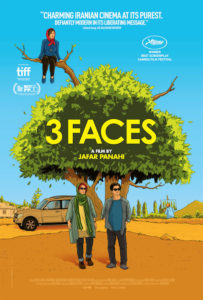
3 Faces (“Se rokh”) (Jafar Panahi, 2018) [the paragraph, below, is an adaptation of a longer review I wrote for Hammer to Nail]
One of the many fine aspects of Iranian director Jafar Panahi’s mesmerizing new film, 3 Faces, is that one need not appreciate its larger, metanarrative about Panahi’s own career and the nature of censorship in Iran to find the central story compelling (a quick glimpse through his biography reveals the lengths to which he has had to go to make films since his political arrest in 2010). We open with stark footage, shot on an iPhone, of young Marziyeh, from a remote village to the northwest of Tehran, appearing to hang herself. The cause of her desperation? Her parents’ refusal to let her study acting in the capital. They have, instead, arranged a marriage to keep her close to home and in her traditional place as a wife. With a sudden cut, we find ourselves in a car with director Panahi and the Iranian actress Behnaz Jafari, playing versions of themselves, driving at night to Marziyeh’s village, Panahi behind the wheel and Jafari watching, over and over, the video of the girl’s death. In that farewell address, Marziyeh directly invokes Jafari as her only hope. “Come save me,” she cries. And so, off Jafari goes, with Panahi as her chauffeur. I will allow what happens to remain a mystery, but what is no mystery is Panahi’s mastery of craft. Always subtle, Panahi treats his subjects with respect, no matter how different their worldview from his own, leading us on a journey of discovery, as well, into the deep truths behind myth and superstition. Our beliefs may differ, but we all seek higher meaning to our lives.
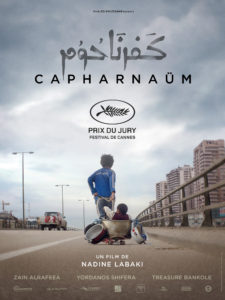
Capernaum (Nadine Labaki, 2018) [the paragraph, below, is an adaptation of a longer review I wrote for Hammer to Nail, which has yet to post, as of this writing]
Among the many brilliant and heart-rending aspects of Nadine Labaki’s Cannes Jury Prize-winner, Capernaum (original title “Capharnaüm”), perhaps the greatest is the performance of 12-year-old Zain Al Rafeea, a Syrian refugee in Beirut whom Labaki discovered and cast in her film. With the eyes of an old sage, the body of an angry tween boy, and the mouth of a coarse sailor, Zain (role and performer bear the same name, blurring the lines between the two) delivers a deeply moving performance as a child fed up with his miserable lot in life. His solution? To sue his parents for having given birth to him, so they will stop bringing more children into this world who will just suffer and starve, as he has done. Amazingly, given the subject matter, Capernaum is not only gripping but also very entertaining, thanks in no small part to Zain’s charisma and the occasional comedy of his actions. Labaki (Caramel) keeps the plot moving quickly through its most distressing parts, always able with image and sound to keep us intently focused on what we need to see. With over 500 hours of footage shot for an eventual two-hour finished movie, it’s a masterwork of docudrama production, showcasing this kind of hybrid filmmaking at its best. The “Capernaum” of the title refers to a city, mentioned in the bible, on the shores of the Sea of Galilee, seen as a “village of consolation” or “shelter of comfort.” There’s not much comfort here, but there is survival, which counts as consolation. Let Labaki’s cinematic stunner, then, open all our eyes to the plight of those less fortunate than ourselves, so we can go forth and offer our own consolation and shelter to everyone in need.


If Beale Street Could Talk (Barry Jenkins, 2018)
From the director of the Oscar-winning Moonlight comes this adaptation of James Baldwin’s 1974 novel of the same name, which took its own title from W.C. Handy’s song “Beale Street Blues” (Beale Street, in Memphis, Tennessee, is considered the “home of the Blues“). Set in New York City in the time of its writing, the movie follows the love story between 19-year-old Tish (the narrator) and her childhood sweetheart (and later, father of her son), Fonny, as their early romantic idyll is destroyed by the actions of a racist white policeman, who sets up Fonny to take the fall for a rape he did not commit. Using carefully considered compositions – including many long, slow tracking shots – and trancelike elliptical editing, Jenkins departs from the more conventional scene-to-scene narrative techniques of his previous work (though stunning, and structured as a triptych, Moonlight was more straightforward in its storytelling), plunging us into a beautiful dream that soon becomes a nightmare. Jenkins is clear, throughout, that this is a situation faced by all African-Americans in this country, using Tish and Fonny’s tragedy as a larger metaphor for the sins of our past and present. Stars KiKi Layne (making her feature-film debut) and Stephan James (Race), as Tish and Fonny, are brilliant in their expressions of passion, disappointment, anger and hope, never less than vibrant on screen, whether together or apart. Bravo to Barry Jenkins for yet another masterpiece, this one even more vital than the last.
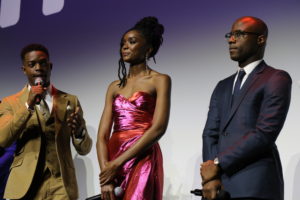

That Time of Year (“Den tid på året”) (Paprika Steen, 2018) [the paragraph, below, is an adaptation of a longer review I wrote for Hammer to Nail, which has yet to post, as of this writing]
From Danish actress/director Paprika Steen (Silent Heart) comes a riveting, bittersweet family drama set during Christmas, as a fractured clan gathers to celebrate the holiday at the home of eldest daughter Katrine (Steen, herself). Expertly directed, the film is part of an honorable cinematic tradition (think Home for the Holidays, among many others) where gatherings that many of us frequently dread are presented in heightened emotional situations, allowing the viewer a moment of blissful schadenfreude: “At least our last reunion wasn’t quite as bad,” we think. Steen and her fine ensemble ably demonstrate that there is life still left in the genre, thanks to a well-written script and a few plot twists that genuinely surprise. I may not want to eat at Katrine’s house next year, but I enjoyed watching her own particular mess play out. Steen, as good an actress as a director, imbues Katrine with a warmth of spirit that makes her insufferable to her guilty-conscience family members but a joy to watch. Sofie Gråbøl (Sarah Lund in the original Danish version of The Killing) has the less enviable task of playing her brittle sister Barbara, but equally holds our attention, as does the rest of the cast. It’s not all Sturm und Drang, either, as Steen and screenwriter Jakob Weis make sure there are plenty of lighter moments, though the ending is quite a brutal shocker. Whatever your own holidays are like, you should find plenty to laugh and cry at in That Time of Year.

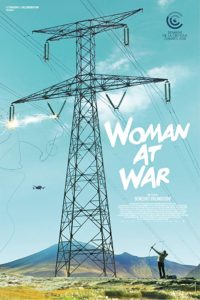
Woman at War (“Kona fer í stríð”) (Benedikt Erlingsson, 2018) [the paragraph, below, is an adaptation of a longer review I wrote for Hammer to Nail, which has yet to post, as of this writing]
Woman at War, from Icelandic director Benedikt Erlingsson (Of Horses and Men), features a powerful central performance from actress Halldóra Geirharðsdóttir (Metalhead) as twin sisters, one of whom is a committed environmentalist who will stop at nothing to keep her government from making a deal to develop Iceland’s untapped natural resources. The film opens with a bang (and a spark), as Geirharðsdóttir’s Halla takes down a section of capital city Reykjavík’s power grid singlehandedly, thanks to a bow, an arrow, a measure of heavy cable, and a strong will. It’s the fifth time she’s done it, and by now the authorities take the threat seriously. Soon, she is on the run, chased by helicopters. Not to fear, though, as the resourceful Halla is not about to be caught so easily. Overall, this is a delightful affair, full of surprises. For such a small country, Iceland appears to have a vibrant film industry, as recent great films like Rams and The Swan amply demonstrate. Not only that, but it offers gorgeous landscapes as backdrops to the stories. Count Woman at War among those other movies’ cinematic compatriots, then, and place it in your queue when the opportunity arises. Its unique blend of activism and humor makes it well worth watching.
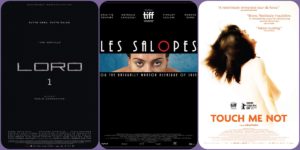
Other films I like include Loro (Paolo Sorrentino), Les Salopes or the Naturally Wanton Pleasure of Skin (Renée Beaulieu) and Berlin Film Festival winner Touch Me Not (Adina Pintilie), which is more of a doc-fiction hybrid than a pure narrative (and all the better for it).
And that’s it for my reports. I hope to return again next year!

